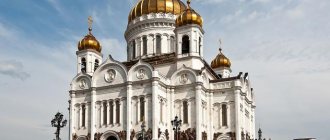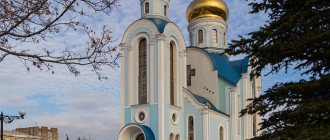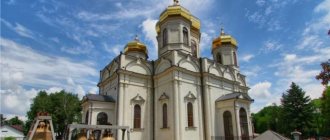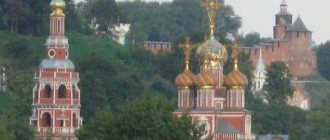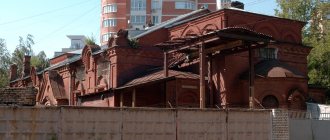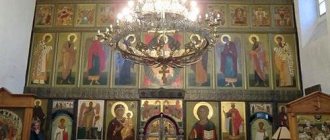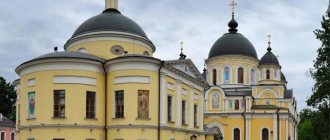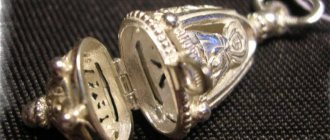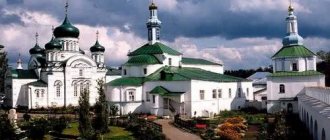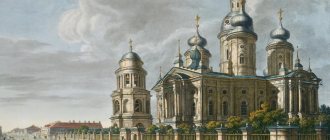Content
- 1 Russia
- 2 Ukraine – Ukrainian Orthodox Church
- 3 Moldova - Orthodox Church of Moldova
- 4 Latvia - Latvian Orthodox Church
- 5 Estonia - Estonian Orthodox Church
- 6 Belarus – Belarusian Exarchate – Belarusian Orthodox Church
- 7 Lithuania
- 8 Kazakhstan - Metropolitan District
- 9 Azerbaijan
- 10 Central Asia
- 11 Europe
- 12 America
- 13 Japan
- 14 DPRK
- 15 China
- 16 Links
Difference from diocese
The main differences are the size and number of the population that lives in a certain territory. Both territorial entities are governed by the highest bishops - the metropolitan and the archbishop. They are independent priests with equal rights in the structure of the Russian Orthodox Church and are subordinate to the highest authority in the Church and the Patriarch of All Rus'.
The title of metropolitan in the Russian Orthodox Church is received for special merits
The Metropolitan coordinates the activities of the archbishops, receives regular reports and heads the councils of the subordinate regions. At the same time, he gives a fair assessment of the activities of the bishops and can petition or ask the Holy Synod and the Patriarch for the resignation of the bishops occupying the see.
Important! The Metropolitan is the connecting link between the main Church Council and diocesan structures, but at the same time the Patriarch can directly coordinate and lead them as well.
Subordinate to the archbishop are dean districts, parishes and monasteries, and only dioceses are part of the metropolis. Thus, in the Russian Orthodox Church there is a strict and clear structured connection from smaller parishes to the highest clergy. This system allows the Patriarch to better understand the needs and desires of the population, as well as to lead the entire Church.
Russia
- Abakan and Kyzyl diocese
- Anadyr and Chukotka Diocese
- Arkhangelsk and Kholmogory diocese
- Astrakhan and Enotaevsk diocese
- Barnaul and Altai diocese
- Belgorod and Stary Oskol diocese
- Birobidzhan and Kuldur diocese
- Blagoveshchensk and Tynda diocese
- Bryansk and Sevsk diocese
- Vladivostok and Primorsky diocese
- Vladimir-Suzdal diocese
- Volgograd and Kamyshin diocese
- Vologda and Veliky Ustyug diocese
- Voronezh and Boris and Gleb diocese
- Vyatka and Sloboda diocese
- Ekaterinburg and Verkhoturye diocese
- Ekaterinodar and Kuban diocese
- Ivanovo-Voznesensk diocese
- Izhevsk and Udmurt diocese
- Irkutsk and Angarsk diocese
- Yoshkar-Ola Diocese
- Kazan and Tatarstan diocese
- Kaluga and Borovsk diocese
- Kemerovo and Novokuznetsk diocese [1]
- Kostroma and Galich diocese
- Krasnoyarsk and Yenisei diocese [2]
- Kurgan and Shadrinsk diocese
- Kursk and Rylsk diocese
- Lipetsk and Yeletsk diocese
- Magadan and Sinegorsk diocese
- Maikop and Adyghe diocese
- The Moscow diocese is the main one. Vicariates - Kolomenskoye and Krutitskoye, Solnechnogorskoye, Volokolamskoye and Yuryevskoye, Istrinskoye, Dmitrovskoye, Vidnovskoye, Ramenskoye, Bronnitskoye, Sergievskoye, Orekhovozuevskoye, Lyuberetskoye, Kashirskoye, Krasnogorskoye
- Murmansk and Monchegorsk diocese
- Nizhny Novgorod and Arzamas diocese
- Novgorod and Staraya Russian diocese
- Novosibirsk and Berd diocese
- Omsk and Tara diocese
- Orenburg and Buzuluk diocese
- Oryol and Liven diocese
- Penza and Kuznetsk diocese
- Perm and Solikamsk diocese
- Petrozavodsk and Karelian diocese
- Petropavlovsk Kamchatka Diocese
- Pskov and Velikoluksk diocese
- Rostov and Novocherkassk diocese
- Ryazan and Kasimov diocese
- Samara and Syzran diocese
- St. Petersburg and Ladoga diocese. Vicariates-Tikhvinskoe [3]
- Saransk and Mordovian diocese
- Saratov and Volsk diocese
- Simbirsk and Melekess diocese
- Smolensk and Kaliningrad diocese
- Stavropol and Vladikavkaz diocese
- Syktyvkar and Vorkuta diocese
- Tambov and Michurinsk diocese
- Tver and Kashin diocese
- Tobolsk and Tyumen diocese
- Tomsk and Asinovsk diocese
- Tula and Belevsk diocese
- Ufa and Sterlitamak diocese
- Khabarovsk and Amur diocese
- Cheboksary and Chuvash diocese
- Chelyabinsk and Zlatoust diocese
- Chita and Transbaikal diocese
- Elista and Kalmyk diocese
- Yuzhno-Sakhalin and Kuril diocese
- Yakut and Lena diocese
- Yaroslavl and Rostov diocese
Russian Orthodox Church - Russian Orthodox Church
The Russian Orthodox Church - ROC, is a multinational Local Autocephalous Church, which is in doctrinal unity and prayerful and canonical communion with other Local Orthodox Churches. It is the largest autocephalous local Orthodox Church in the world, as well as the most influential religious organization in Russia. The basis for the organization and activities of the Russian Orthodox Church is the Holy Scripture, as well as the Holy Tradition. The latter includes the canons, liturgical texts authorized by the Church, the works of the Holy Fathers, the lives of the Saints, as well as the customs of the Church.
The autonomous and self-governing churches, exarchates, metropolitan districts, dioceses, synodal institutions, deaneries, parishes, monasteries, brotherhoods, sisterhoods, religious educational institutions, representative offices and metochions that are part of the Russian Orthodox Church canonically constitute the Moscow Patriarchate. The diocese is one of the main units of the administrative-territorial division of the Russian Orthodox Church, ROC, created for local administration. The composition of the diocese and its boundaries are established by the Holy Synod, and then by the Council of Bishops. The Russian Orthodox Church has more than three hundred dioceses, which are united into metropolitanates.
Metropolises of the Russian Orthodox Church
Metropolises of the Russian Orthodox Church
Altai Metropolis Arkhangelsk Metropolis Astrakhan Metropolis Bashkortostan Metropolis Belgorod Metropolis Bryansk Metropolis Buryat Metropolis Vladimir Metropolis Volgograd Metropolis Vologda Metropolis Voronezh Metropolis Vyatka Metropolis Don Metropolis Ekaterinburg Metropolis ii Transbaikal Metropolis Ivanovo Metropolis Irkutsk Metropolis Kaliningrad Metropolis Kaluga Metropolis Karelian Metropolis Kostroma Metropolis Krasnoyarsk Metropolis Kuban Metropolis Kuzbass Metropolis Kurgan Metropolis Kursk Metropolis Lipetsk Metropolis Mari Metropolis Minsk Metropolis (Belarusian Exarchate) Mordovian Metropolis Murmansk Metropolis Nizhny Novgorod Metropolis Novgorod Metropolis Novosibirsk Metropolis Omsk Metropolis Orenburg Metropolis Orel Metropolis Penza Metropolis Perm Metropolis ii Amur Metropolis Primorye Metropolis Pskov Metropolis Ryazan Metropolis Samara Metropolis St. Petersburg Metropolis Saratov Metropolis Simbirsk Metropolis Smolensk Metropolis Stavropol Metropolis Tambov Metropolis Tatarstan Metropolis Tver Metropolis Tobolsk Metropolis Tomsk Metropolis Tula Metropolis Udmurt Metropolis Khanty-Mansi Metropolis Chelyabinsk Metropolis Chuvash Metropolis Yaroslavl Metropolis
Foreign institutions of the Russian Orthodox Church
Foreign institutions of the Russian Orthodox Church
Spiritual and educational center named after St. Genevieve of Paris at the Korsun diocese Korean Orthodox Spiritual Mission (ROCOR) Patriarchal deanery of parishes of the Russian Orthodox Church in the Republic of Armenia Patriarchal deanery of parishes of the Russian Orthodox Church in Turkmenistan Patriarchal parishes in Canada Patriarchal parishes in the USA Representation of the Russian Orthodox Church at European international organizations Parishes of the Moscow Patriarchate in the Italian Republic Russian spiritual mission in Korea Russian spiritual mission in Jerusalem Church of the Holy Trinity and Iveron Chapel in Belgrade (metochion of the Russian Orthodox Church)
On December 20, 2022, the former press secretary of Patriarch Kirill of Moscow and All Russia, priest Alexander Volkov, headed the Information Commission of the Moscow Diocese. In his new position, he will coordinate and control temple information resources.
On October 7, 2022, following a meeting of the Holy Synod of the Russian Orthodox Church, the Archdiocese of Russian Churches in Western Europe entered the jurisdiction of the Moscow Patriarchate, which made a corresponding request to Patriarch Kirill of Moscow and All Russia. They also established a special management regime for her, consistent with her tradition.
On September 14, 2022, the Holy Synod of the Russian Orthodox Church accepted the head of the “Russian Exarchate” in Europe, Archbishop John, and clergy who wish to do so into the jurisdiction of the Moscow Patriarchate. In addition, members of the Holy Synod gave Archbishop John the title “Dubninsky” and appointed him administrator of the parishes of the Russian Exarchate in Western Europe.
On September 11, 2022 , by order of Patriarch Kirill of Moscow and All Russia, the head of the patriarchal press service, Priest Alexander Volkov, was relieved of his post. Vladimir Legoida, Chairman of the Synodal Department for Relations of the Church with Society and the Media, was appointed acting press secretary of the patriarch.
On February 20, 2015, at the Moscow Patriarchal Residence, Patriarch Kirill of Moscow and All Russia awarded Sakhalin Governor Alexander Khoroshavin with the Order of St. Sergius of Radonezh, III degree, for his attention to his work for the benefit of the Sakhalin diocese.
On February 1, 2009, the enthronement of the newly elected head of the Russian Orthodox Church, the sixteenth Patriarch of Moscow and All Russia Kirill took place in the Cathedral of Christ the Savior in Moscow. The elevation to the patriarchal throne, performed during the Divine Liturgy, is an epoch-making event in the life of the entire Church, and therefore is always distinguished by special solemnity.
On January 27, 2009, Metropolitan Kirill of Smolensk and Kaliningrad was elected by the Local Council of the Russian Orthodox Church as the 16th Patriarch of Moscow and All Russia, gaining 508 votes out of 677, that is, 75%. Two days earlier, by the Bishops' Council of the Russian Orthodox Church in Moscow, held under his chairmanship, Metropolitan Kirill was elected one of three candidates for the Moscow Patriarchal throne: having received 97 votes out of 197 valid ballots.
On February 24, 1901, the Supreme Holy Synod excommunicated Leo Tolstoy from the Orthodox Church. The definition was signed by Metropolitan Anthony and six other senior hierarchs. On the same day, the official organ of the Holy Governing Synod, the journal Tserkovnye Vedomosti, published a Determination with a message from the Holy Synod on the fall of Count Leo Tolstoy from the Church. The next day it was published in all major newspapers in Russia.
On February 23, 1847, the highest resolution of Russian Emperor Nicholas I approved a report on the establishment of the Russian Ecclesiastical Mission in Jerusalem. The creation of a representative office of the Russian Orthodox Church in the Holy Land was necessary to promote the strengthening of Orthodoxy in the region, maintain relations with the Jerusalem Church, as well as organize and conduct pilgrimage programs. Archimandrite Porfiry was appointed Head of the Mission.
May 28, 1722 , on the urgent initiative of Peter I, a resolution was adopted by the Holy Synod of the Russian Orthodox Church, ordering a direct violation of the secrecy of church confession in the interests of state power.
On February 25, 1721, in St. Petersburg, Peter I established the Spiritual Synod to govern the Church, headed by the chief prosecutor, directly subordinate to the tsar. The regulations stated that the state body of church administration, the Synod, on the principle of “ministry,” was created from senior bishops who deal with issues and matters of doctrine, religious, moral life, structure, management and discipline of Christian society.
On April 3, 33, the death of Jesus Christ occurred, sentenced to crucifixion at the trial of Pilate. The exact date of death of the central figure of Christian religious teaching was established by geologists who, according to the Gospel of Matthew, were able to prove that at the moment of the Savior’s death an earthquake actually occurred in Palestine.
Ukraine – Ukrainian Orthodox Church
- Belotserkovskaya diocese
- Vinnytsia diocese
- Vladimir-Volyn diocese
- Gorlovka diocese
- Dnepropetrovsk diocese
- Donetsk diocese
- Zhytomyr diocese
- Zaporozhye diocese
- Ivano-Frankivsk diocese
- Kamenets-Podolsk diocese
- Kyiv diocese - main. Vicariates - Vasilkovskoe, Vyshgorodskoe
- Kirovograd diocese
- Konotop diocese
- Krivoy Rog diocese
- Lugansk diocese
- Lutsk diocese
- Lviv diocese
- Mukachevo diocese
- Nikolaev diocese
- Ovruch diocese
- Odessa diocese
- Poltava diocese
- Rivne diocese
- Sarny diocese
- Simferopol diocese
- Sumy diocese
- Ternopil diocese
- Tulchin diocese
- Kharkov diocese
- Kherson diocese
- Khmelnitsky diocese
- Khust diocese
- Cherkasy diocese
- Chernigov diocese
- Chernivtsi diocese
Ukraine [edit]
Dioceses of the Ukrainian Orthodox Church (Moscow Patriarchate) as of January 2014
Dioceses of the Ukrainian Orthodox Church (Moscow Patriarchate): [2]
| Diocese | See | Based | Official site |
| Alexandria and Svetlovodsk | Alexandria | 2007 | [212] |
| Balta and Ananyev | Balta | 2012 | [213] |
| Bila Tserkva and Boguslav | White church | 1994 | [214] |
| Berdyansk and Primorye | Berdyansk | 2007 | [215] |
| Boryspil and Brovary | Boryspil | 2013 | [216] |
| Vinnitsa | Vinnitsa | 1933 | [217] |
| Mogilev-Podolsky | Mogilev-Podolsky | 2013 | [218] |
| Vladimir-Volynsky and Kovel | Vladimir-Volynsky | 1996 | [219] |
| Gorlovka and Slavyansk | Gorlovka | 1994 | [220] |
| Dzhankoy and Rozdolnoe | Dzhankoy | 2008 | [221] |
| Kamenskoye and Tsarichanka | Kamenskoye | 2010 | [222] |
| Dnepropetrovsk and Pavlograd | Dnieper | 1775 | [223] |
| Donetsk and Mariupol | Donetsk | 1944 | [224] |
| Feodosia | Feodosia | 2012 | [225] |
| Zhytomyr and Novograd-Volynsky | Zhytomyr | 1940 | [226] |
| Zaporozhye and Melitopol | Zaporozhye | 1992 | [227] |
| Ivano-Frankivsk and Kolomyia | Ivano-Frankivsk | 1957 | [228] |
| Izyum and Kupyansk | Raisin | 2012 | [229] |
| Kamenets-Podolsky and Gorodok | Kamenets-Podolsky | 1795 | [230] |
| Kyiv | Kyiv | 988 | [231] |
| Kirovograd and Novomirgorod | Kropyvnytskyi | 1942 | [232] |
| Konotop and Glukhov | Konotop | 1993 | [233] |
| Kremenchuk and Lubny | Kremenchuk | 2007 | [234] |
| Krivoy Rog and Nikopol | Krivoy Rog | 1996 | [235] |
| Lugansk and Alchevsk | Lugansk | 1991 | [236] |
| Lutsk and Volyn | Lutsk | 11th century | [237] |
| Lviv and Galicia | Lviv | 1539 | [238] |
| Mukachevo and Uzhgorod | Mukachevo | 1945 | [239] |
| Nizhyn and Pryluky | Nizhyn | 2007 | [240] |
| Nikolaev | Nikolaev | 1992 | [241] |
| Voznesensk | Voznesensk | 2012 | [242] |
| New Kakhovka and Genichesk | New Kakhovka | 2007 | [243] |
| Ovruch and Korosten | Ovruch | 1993 | [244] |
| Odessa and Izmail | Odessa | 1837 | [245] |
| Poltava and Mirgorod | Poltava | 1799 | [246] |
| Rivne and Ostrog | Smooth | 1990 | [247] |
| Rovenki | Rovenki | 2013 | [248] |
| Romny | Romny | 2013 | [249] |
| Sarny and Polesskoe | Sarny | 1999 | [250] |
| Severodonetsk and Starobelsk | Severodonetsk | 2007 | [251] |
| Simferopol and Crimea | Simferopol | 1859 | [252] |
| Sumy and Okhtyrka | Sumy | 1943 | [253] |
| Ternopil and Kremenets | Ternopil | 1988 | [254] |
| Tulchin and Bratslav | Tulchin | 1994 | [255] |
| Uman and Zvenigorodka | Uman | 2008 | [256] |
| Kharkov and Bogodukhov | Kharkiv | 1799 | [257] |
| Kherson and Tavriysk | Kherson | 1837 | [258] |
| Khmelnitsky and Starokonstantinov | Khmelnitsky | 1955 | [259] |
| Khust and Vinogradov | Khust | 1994 | [260] |
| Cherkasy and Kaniv | Cherkasy | 1992 | [261] |
| Chernigov and Novgorod-Seversky | Chernigov | 11th century | [262] |
| Chernivtsi and Bukovina | Chernivtsi | 1941 | [263] |
| Shepetivka and Slavuta | Shepetivka | 2007 | [264] |
Europe
- Diocese of Berlin
- Diocese of Brussels
- Hungarian diocese
- Diocese of Vienna
- Diocese of The Hague
- Diocese of Korsun (France, Italy, Spain, Portugal)
- Diocese of Sourozh (Great Britain, Ireland)
